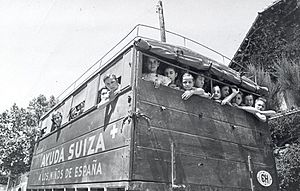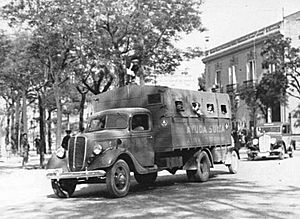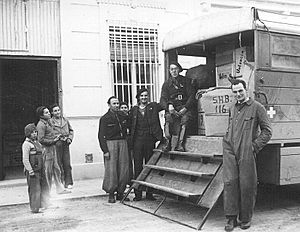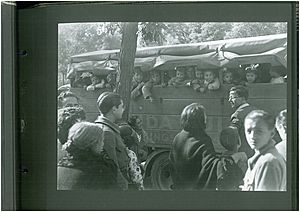Ayuda Suiza facts for kids

Evacuation of children in 1937 during the Spanish Civil War.
|
|
| Founder | Rodolfo Olgiati |
|---|---|
| Purpose | Humanitarian Aid |
| Location |
|

The Comité Suizo de Ayuda a los niños de España (which means "Swiss Aid Committee for the Children of Spain") was a special group of Swiss organizations. It was better known as Ayuda Suiza ("Swiss Aid"). This group brought together many different Swiss organizations. They all worked together to help children during the Spanish Civil War (1936-1939). The original German name was Schweizerisches Hilfskomitee für die Kinder Spaniens (SAS). In French, it was called Comité neutre de secours aux enfants d'Espagne.
Contents
How Swiss Aid Started

The Swiss Aid Committee began in February 1937. It was started by Rodolfo Olgiati. He was the secretary of a peace-focused group called Service Civil International (SCI). Rodolfo Olgiati wanted to help people in Spain. He worked to get many Swiss groups to join in offering humanitarian aid.
The Swiss government first hesitated to approve this plan. They wanted to stay strictly neutral in the conflict. However, they eventually gave their permission. The SCI group was very important to the committee. They provided the most volunteers to work on the ground. About thirty volunteers, mostly from Switzerland, helped throughout the war. Rodolfo Olgiati also served as the committee's secretary.
What Swiss Aid Did
The main goal of Swiss Aid was to help children. They also helped other people who were in need. This included older people, pregnant women, and mothers who were breastfeeding.
Swiss Aid wanted to help both sides in the conflict. But in reality, they mostly worked in the Republican areas. This was because the Nationalist side often refused their help.
Swiss Aid had local groups in several Spanish cities. These included Madrid, Barcelona, Valencia, and Murcia.
Key Activities of Volunteers
The volunteers had many important jobs. They managed places where people could get food, called canteens. They also helped move children from dangerous war zones to safer places. Volunteers sent important supplies, like food and clothes, to children's homes, shelters, and hospitals. They also provided support to these places. This included direct help and finding sponsors. They worked closely with Spanish groups and local organizations. These groups helped take care of refugee children and families.
Swiss Aid volunteers also worked with the Quakers on many missions. Many members of SCI helped with Swiss Aid. Some of these people were Elisabeth Eidenbenz, Ruth von Wild, Karl Ketterer, Irma Schneider, Ralph Hegnauer, Trudi Ketterer, Maurice Dubois, Elsbeth Kasser, Willy Begert, and Eleonore Imbelli.
How Swiss Aid Changed
In January 1939, most Swiss Aid volunteers left Spain. Within a few months, they started working again in southern France. They helped thousands of refugees who were in camps there. They also found children from the sponsored homes who had moved to France. During this time, they created new children's homes and maternity wards. One famous example is the Elna Maternity. They also helped in various internment camps.
In 1940, the world changed with the start of World War II. Swiss Aid adapted to this new situation. It was renamed the Swiss Cartel for Relief to Children Victims of War. Its German name was Schweizerischen Arbeitsgemeinschaft für kriegsgeschädigte Kinder (SAK). It remained a neutral NGO group. The SCI continued to lead it. Their work expanded to help all refugee children from war zones. More children began arriving from northern France because of World War II.
From 1942, the Swiss Red Cross took over the platform. They expanded the humanitarian work across all of France. They used the same aid methods that had been successful during the Spanish Civil War.
See also
 In Spanish: Ayuda Suiza para niños
In Spanish: Ayuda Suiza para niños


